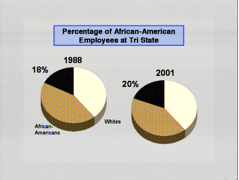By Dr. Ken Broda Bahm:

Litigators have many options for using on-screen visuals in opening statement. They can fire up the Elmo document camera, they can call up and highlight documents using TrialDirector or Sanction, or they can do what savvy trial lawyers are increasingly doing: using PowerPoint slides. Here at Persuasion Strategies, we used to be agnostic about that choice saying, “Use whatever you’re most comfortable with.” But more recently, our experience has been pointing in one direction: use PowerPoint (or for Mac fans, Keynote). The smooth continuity and the easy ability to create effective visual reinforcement for the verbal message makes for a more engaging and impactful opening statement. It also avoids the fumbling moments of placing documents upside-down under the Elmo, as well as the banter between the presenter and the TrialDirector operator (“Please pull out the second paragraph…no, not that paragraph, the one below it…that one, right there, highlight that…no, I mean call it out”).
Not only is PowerPoint simpler for the presenter (and the courtroom technician), it is also more effective according to a recent controlled study (Park & Feigenson, 2013). When tested, plaintiffs and defendants were not only more understandable and more credible when using PowerPoint to supplement their opening statement, they were also more likely to get to a favorable liability judgment. This appears to be the first controlled study published in a peer-reviewed journal to document what has been known intuitively by many of the experienced litigators we work with: audiences, including juries, are coming to expect a professional visual accompaniment, and at least when it is used well, PowerPoint actually seems to give your point some power. This post takes a look at the study, and also shares a few ways you can use PowerPoint in trial, in opening statement and beyond.
First Published Study Testing PowerPoint in Trial Openings: It Works
We’ve written previously on the advantage of using visual presentation, noting both our own research, as well as other reports we’ve come across (e.g., Atherton, 2009). But the research from Jaihyun Park and Neil Feigenson (2013) appears to be the first study in a peer-reviewed journal to test the effectiveness of PowerPoint use versus nonuse, specifically in a trial context.
Using a fact pattern based on a racial discrimination case against a railroad, the researchers varied the presentation: Holding the attorney presentation (including video, arguments, and language) constant, they created versions with the attorney either supplementing the opening statement with slides, or not, and they did that for both the plaintiff’s presentation and the defendant’s. That created four conditions: Neither side used PowerPoint, plaintiff used and defendant didn’t, defendant used and plaintiff didn’t, and both used PowerPoint. Assigning participants randomly into those conditions, they tested case verdicts, source credibility, and message comprehension.
One of the central questions the researchers were interested in is whether PowerPoint use served as a substantive aid for juror’s processing of the message, or as a more superficial cue to whether the attorney was prepared, or both. That questions ties into what is known as the “Elaboration Likelihood Model” in communication, or ELM. Based on research conducted in the early 1980’s, the theory suggests a “dual process” that message receivers can follow. Sometimes we take the “central route” of carefully processing and evaluating the reasons, and other times we take the more peripheral route of relying on more peripheral cues like the assumed credibility of the source. In other words, sometimes we read the book, and sometimes we judge the cover. So in answer to the question of whether PowerPoint aids the “readers” or the “cover judgers,” so to speak, the answer is “both.” As tested in this study, the use of PowerPoint aided comprehension, causing jurors to retain more of the message, and it also aided the credibility of the attorney using PowerPoint. Especially where there was a contrast with one side using the tool and the other side not, PowerPoint use told jurors that the slide using side was more prepared and, hence, more believable than the other side.
The bottom line is that PowerPoint use affected the verdict. “When either party used PowerPoint slides,” the authors concluded, “mock jurors tended to judge the defendant’s legal responsibility in a direction favoring that party.” That means that the employer was more likely to be found liable for discrimination when the plaintiff used PowerPoint and less likely to be found liable when the defendant used PowerPoint. The implication is that this might settle the debate over whether it is useful or not for the attorney to use slides.
But…Depends on How You Use It
In summarizing their results, Park and Feigenson describe the relationship as robust and unambiguous: The side with slides did better at the levels of credibility, comprehension, and verdict. “It is also noteworthy that this effect was obtained using PowerPoint slides that were relatively simple and few in number,” they write, “The impact of more extensive and dramatic visual displays (such as those that legal visual consultants often design for lawyers) on decision making in actual cases might well be greater.”
 That should probably be the next study, testing various types or approaches to slide use, similar to our study that tested the effectiveness of static or animated graphics, as well as the approach of “graphic immersion” (using slides continuously) versus the occasional use of graphics.
That should probably be the next study, testing various types or approaches to slide use, similar to our study that tested the effectiveness of static or animated graphics, as well as the approach of “graphic immersion” (using slides continuously) versus the occasional use of graphics.
Park and Feigenson in their study used limited and simple graphics, including this one (on the right). Importantly, the slides were not just text bullets on screen, the “read along with me” approach that we’ve seen used by far too many attorneys. There is reason to believe that a text-heavy presentation is worse than the use of simpler visuals, and potentially worse than not using slides at all.
So the advice is not simply, “Use PowerPoint,” but “Use PowerPoint well,” which means finding simple and compelling visuals which supplement your message, and make it easier for jurors to follow your message.
Include Your On-Screen Presentation in All Phases of Trial Preparation
So when should litigators use PowerPoint? I can think of at least four areas:
Test Your PowerPoint in Your Mock Trial
Small group research prior to trial — a focus group or a mock trial — is an ideal time to test all facets of your preparation, including your PowerPoint slides for opening statement. As a follow-up to the research, we will often include a slide-by-slide critique of the attorney’s visual approach and recommend improvements along the way.
Use Your PowerPoint in Your Opening
The Opening is uniquely suited to the PowerPoint presentation mode because you are telling a story, providing an overview, giving the panel the proverbial “picture on the cover of the puzzle box.” Use that opportunity to provide a structure and a preferred framework, and also to visually introduce the witnesses, key documents, and where allowed, the law and instructions they will be applying as well.
Use PowerPoint in Expert Examination
Though it wasn’t tested in the Park and Feigenson research, nor in any other study I’m aware of, I’ve become convinced that an expert witness’s use of PowerPoint can be even better than an attorney’s use. Let the expert prepare a set of slides laying out their methods and conclusions, and provide help to make sure the slides are well-designed and comprehensible. Then during direct, let them walk through the slides and wield the “clicker” and suddenly they’re the “teacher” rather than the “witness.”
Use PowerPoint in Closing Argument
It is typical that openings receive intense preparation, while closings are created on-the-fly during the stress of trial. Some attorneys feel they don’t have time to do a “big production” at the end of the case, and others will feel that by this point, jurors will have already seen it all and will just want to focus on evidence. But there are some great ways in which a closing can be prepared during trial and then used to provide very impactful visuals at the point at which many jurors are making up their minds or preparing to argue for their preferred party. For example, when I’m sitting in trial, I’ll keep track of helpful moments in testimony, and create slides of the best from each day’s testimony, including a picture of the witness, a date and transcript reference if available, and a full sentence title summarizing the point made. Each slide can then be put into the verdict form order once you know it, providing ammunition for each preferred conclusion.
Ultimately, it isn’t a matter of just preparing a compelling argument or opening, and then adding some slides to illustrate it. Instead, the visual component should be considered not just the frosting on the cake, but an integral part of the overall message.
______
Other Posts on PowerPoint:
- For Opening Statement (or Any Other Presentation), Keep Your Speaking Notes Off the Screen
- Ban the Bullet (From Your Slides)
- Show, Don’t Just Tell: Part 2, Comprehension (Persuasion Strategies Visual Persuasion Study)
______
Park, J., & Feigenson, N. (2013). Effects of a Visual Technology on Mock Juror Decision Making Applied Cognitive Psychology, 27 (2) DOI: 10.1002/acp.2900
Photo Credit: MikeMurry, Flickr Creative Commons